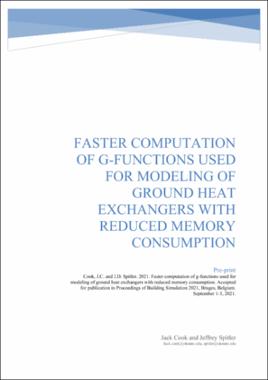| dc.contributor.author | Cook, Jack C. | |
| dc.contributor.author | Spitler, Jeffrey D. | |
| dc.date.accessioned | 2022-04-26T18:35:38Z | |
| dc.date.available | 2022-04-26T18:35:38Z | |
| dc.date.issued | 2021-09-01 | |
| dc.identifier | oksd_spitler_fastercomputationofgfunctions_2021 | |
| dc.identifier.citation | Cook, J. C., & Spitler, J. D. (2021). Faster computation of g-functions used for modeling of ground heat exchangers with reduced memory consumption. Paper presented and accepted for publication in Proceedings of Building Simulation, Bruges, Belgium. September 1-3, 2021. | |
| dc.identifier.uri | https://hdl.handle.net/11244/335283 | |
| dc.description | This is a preprint of a paper presented at conference whose final version has been published in the Proceedings of Building Simulation, International Building Performance Simulation Association, September 2021. | |
| dc.description.abstract | Temperature response functions, known as g-functions, are a computationally efficient method for simulating ground heat exchangers (GHEs), used with ground-source heat pump (GSHP) systems or direct ground cooling systems as part of a whole-building energy simulation. In fact, at present, there are no other methods that have sufficient accuracy and are fast enough to simulate a ground-source heat pump system in a whole-building energy simulation. | |
| dc.description.abstract | The concept, mathematical derivation and an implementation of a g-function calculation program were originally developed by Claesson and Eskilson (1985). More recently (Cimmino 2018a, Cimmino 2018b, Cimmino 2019) developed an open-source g-function calculation tool known as pygfunction. This tool offers great flexibility for the user to compute g-functions for specific configurations of boreholes. However, for large borehole configurations (with ~1000 boreholes), the required time to compute a single g-function can take several hours, and the required RAM can be on the order of 100 GB, greatly exceeding most desktop PCs. In order to develop libraries of g-functions and training sets for machine learning approaches, we are computing hundreds of thousands of g-functions. This paper describes further development of Cimmino's methodology to speed the computation and reduce the memory requirements. | |
| dc.format | application/pdf | |
| dc.language | en_US | |
| dc.publisher | International Building Performance Simulation Association | |
| dc.rights | This material has been previously published. In the Oklahoma State University Library's institutional repository this version is made available through the open access principles and the terms of agreement/consent between the author(s) and the publisher. The permission policy on the use, reproduction or distribution of the material falls under fair use for educational, scholarship, and research purposes. Contact Digital Resources and Discovery Services at lib-dls@okstate.edu or 405-744-9161 for further information. | |
| dc.title | Faster computation of g-functions used for modeling of ground heat exchangers with reduced memory consumption | |
| osu.filename | oksd_spitler_fastercomputationofgfunctions_2021.pdf | |
| dc.description.department | Mechanical and Aerospace Engineering | |
| dc.type.genre | Conference proceedings | |
| dc.type.material | Text | |
| osu.authorOrcid.uri | ORCID: 0000-0003-0826-0512 (Spitler, JD) | |
